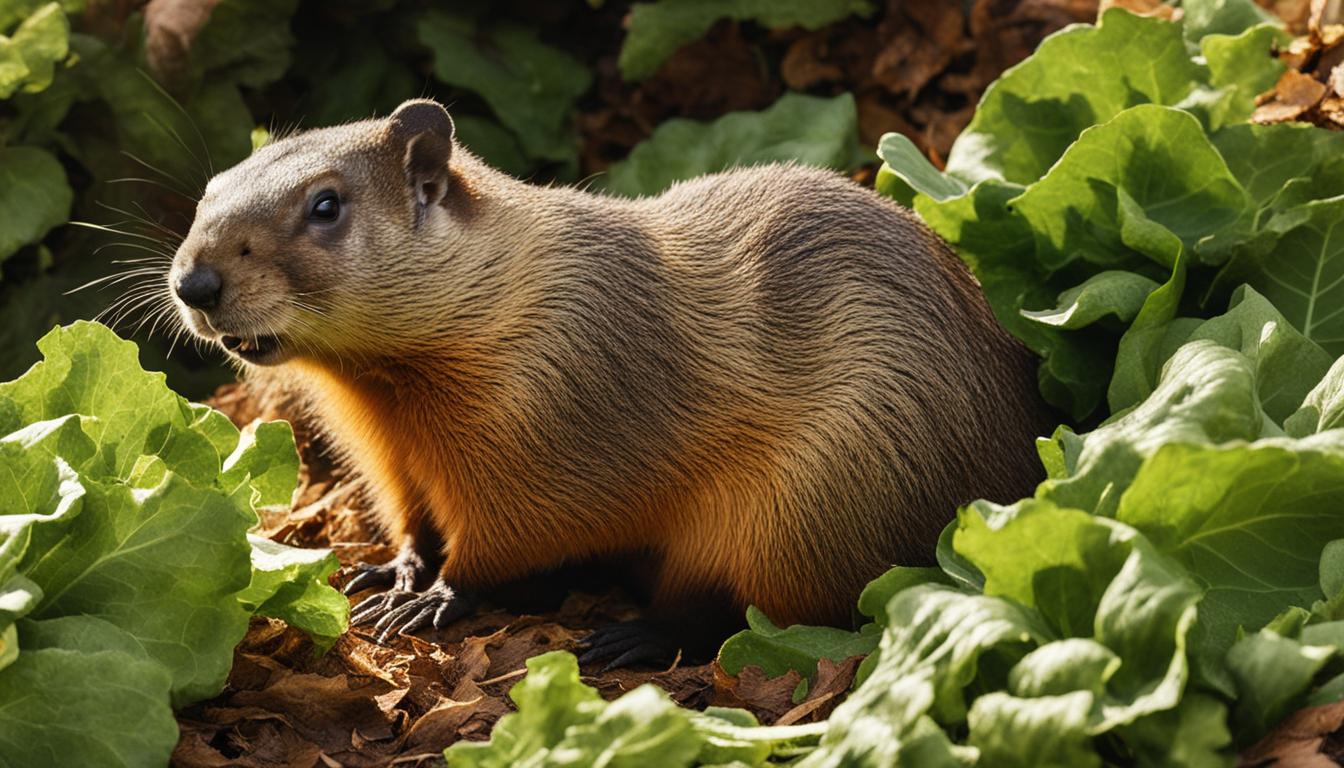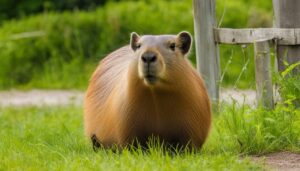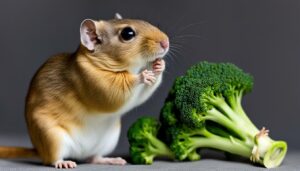Groundhogs, also known as woodchucks, are known for their preference for a herbivorous diet. But what about cat food? Can groundhogs eat cat food? Let’s delve into their food preferences to find out!
While groundhogs may eat cat food if it’s their primary option, it’s not their first choice. Their natural diet consists of greens, fruits, and vegetables, making cat food less suitable for their nutritional needs. Cat food is high in carbohydrates, which is not ideal for groundhogs who prefer a more plant-based diet.
To attract groundhogs to your yard, it’s important to provide them with more suitable food options. Planting specific plants that groundhogs enjoy can be a great way to entice them. We’ll explore more about groundhog food preferences and suitable plants in the sections to come.
Key Takeaways:
- Groundhogs may eat cat food if it’s their primary option, but it’s not their preferred choice.
- They have a preference for a herbivorous diet consisting of greens, fruits, and vegetables.
- Cat food is not recommended for groundhogs as it is high in carbohydrates and does not meet their nutritional needs.
- Planting specific plants that groundhogs enjoy can help attract them to your yard.
- Giving groundhogs more suitable food options can help prevent them from damaging your garden.
What Do Groundhogs Normally Eat?
Groundhogs are primarily herbivores and have specific eating habits and diet preferences. They enjoy a variety of greens, making them fans of lettuce, alfalfa, clovers, dandelions, and red mulberry leaves. These leafy greens provide them with essential nutrients and fiber.
Fruits are also a part of their diet, and groundhogs particularly enjoy berries, cherries, and apples. These sweet treats are a delightful addition to their meals.
In addition to greens and fruits, groundhogs feed on various types of vegetation. They relish crunchy vegetables like carrots and celery. They also have a fondness for corn, peas, and beans, which provide them with carbohydrates and additional nutrients.
While groundhogs are mainly focused on consuming plant-based foods, they may occasionally include insects in their diet. Snails and grasshoppers are a few examples of insects that groundhogs might eat on rare occasions. However, their diet predominantly consists of greens, fruits, and vegetables.
Do Groundhogs Eat Cat Food?

Groundhogs may eat cat food if it’s their primary option, but it is not typically their preferred choice. Cat food is high in carbs and does not meet the nutritional needs of groundhogs. These furry creatures have a natural preference for a more herbivorous diet that consists of greens, fruits, and vegetables.
Attracting Groundhogs with Garden Plants

If you want to attract groundhogs to your yard, you can plant certain plants that they enjoy. Groundhogs have specific nutritional needs and food preferences, so providing them with their preferred food options can help create an inviting environment.
Groundhogs love a variety of garden plants, including:
- Peas
- Lettuce
- Beans
- Plantain
- Broccoli
- Clover
Creating a special groundhog patch in your garden, dedicated to these plants, can be an effective way to provide them with their preferred feeding ground and encourage them to visit your yard. It’s important to note that groundhogs are primarily herbivores and have specific nutritional needs, so offering a variety of plants is essential.
However, it’s important to take measures to protect your garden from groundhog damage. Groundhogs can be voracious foragers and may cause damage to your plants. To deter them from accessing your garden and eating your plants, consider using chicken wire and poles to create barriers around your garden beds. This will help keep your plants safe while still attracting groundhogs to feed on the plants you have provided specifically for them.
Deterring Groundhogs from Your Yard

If you want to deter groundhogs from invading your yard, there are several effective methods you can try. Groundhogs have specific food preferences, and by using certain deterrents, you can discourage them from entering your property.
One natural deterrent that groundhogs dislike is the smell of ammonia. By sprinkling it around the perimeter of your yard or near their burrows, you can create an unpleasant environment that they will want to avoid.
Another option is to use lawn ornaments such as spinning pinwheels or vibrating devices. These moving objects can startle groundhogs and make them feel uncomfortable, discouraging them from staying in your yard.
A third option is to use garlic or pepper spray. Spraying it on plants or at the entrance of groundhog burrows can create a scent that groundhogs find unpleasant, making them less likely to stick around.
Additionally, you can try sprinkling Epsom salts around groundhog burrows. Groundhogs do not like the taste or texture of Epsom salts, so this can be an effective way to deter them.
Groundhogs also dislike the scent of human or pet hair. Tying bundles of hair to garden stakes and placing them around your yard can act as a natural repellent and discourage groundhogs from venturing into your property.
Remember, while these deterrents can be effective, it’s important to combine them with other preventive measures such as securing fences, sealing entrances to burrows, and using groundhog-resistant plants in your garden.
Groundhog-Resistant Plants
If you want to protect your garden from groundhog damage, consider planting groundhog-resistant plants. These plants have characteristics that groundhogs find unappealing, making them less likely to target your garden for food.
- Fountain grass: With its spiky leaves, fountain grass can deter groundhogs.
- Heather: Groundhogs do not like the strong scent and woody texture of heather.
- Lamb’s ear: The fuzzy leaves of lamb’s ear can deter groundhogs from feeding on them.
- Lavender: Groundhogs dislike the strong scent of lavender, making it a good choice for a groundhog-resistant plant.
By strategically planting these types of plants in areas of your garden that are not protected, you can create a barrier that groundhogs are less likely to breach. Combining these groundhog-resistant plants with the deterrent methods mentioned earlier can significantly reduce the likelihood of groundhogs causing damage to your yard.
Groundhog-Resistant Plants

If you want to protect your garden from groundhogs and deter them from feeding on your produce, there are certain plants that you can consider. These groundhog-resistant plants have properties that groundhogs do not enjoy, making them less likely to be targeted by these critters.
Here are some examples of groundhog-resistant plants:
- Fountain Grass: Known for its ornamental feathery plumes, fountain grass adds beauty to your garden while deterring groundhogs.
- Heather: This low-growing evergreen shrub produces colorful blooms and has a strong fragrance that groundhogs are less likely to appreciate.
- Lamb’s Ear: With its soft, fuzzy leaves, lamb’s ear is not a favorite of groundhogs, making it a good choice for groundhog-proof areas of your garden.
- Lavender: Groundhogs tend to avoid plants with strong scents, and lavender’s aromatic flowers are a natural repellent.
By planting these groundhog-resistant plants in areas of your garden that are not protected, you can help prevent groundhogs from feasting on your beloved plants and vegetables.
Groundhog Behavior and Interaction with Pets

When it comes to pets, groundhogs are generally not considered a threat. These furry creatures typically focus on grazing and foraging for their preferred plant-based diet, rather than bothering with cat food. While larger dogs may chase and potentially harm a groundhog, cats are rarely threatened by them. It’s important, however, to keep pets safe and prevent any direct interactions between them and groundhogs to avoid potential bites or territorial disputes.
Groundhogs have their own unique behaviors and instincts, which can sometimes clash with those of our pets. By understanding groundhog behavior, you can ensure the safety of both your pets and these fascinating creatures.
- Curiosity: Groundhogs are curious animals and may approach pets out of curiosity. It’s essential to avoid situations where direct contact can occur to prevent any potential conflicts.
- Territoriality: Groundhogs are territorial creatures and may become defensive if they feel their space is invaded. This can result in aggressive behavior, including biting. Keeping pets at a safe distance can help avoid any confrontations.
- Nocturnal Habits: Groundhogs are diurnal, meaning they are mostly active during the day. They may retreat to their burrows for sleep during the night. Keeping pets indoors during groundhog active hours reduces the likelihood of encounters.
To better understand groundhog behavior and ensure your pets’ safety, it’s recommended to consult with professionals or local wildlife experts. They can provide valuable insights and guidance on how to promote peaceful coexistence between pets and groundhogs.
Groundhog Sleeping and Feeding Patterns

Groundhogs, also known as woodchucks, are diurnal creatures, which means they are primarily active during the day. Their feeding and foraging habits are closely tied to their daily routine. During the summer months, groundhogs typically feed on plants and forage in the mornings and late afternoons.
Groundhogs have distinct eating habits and preferences. They primarily consume a variety of plants, including greens such as lettuce, alfalfa, clovers, dandelions, and red mulberry leaves. They also enjoy fruits like berries, cherries, and apples. Additionally, groundhogs feed on vegetables like carrots, celery, corn, peas, and beans. Although they are herbivores, groundhogs may occasionally eat insects like snails and grasshoppers.
Groundhogs have an interesting pattern of hibernation. From October to February, they enter a state of hibernation. During this period, they rely on the fat reserves they have built up throughout the year. As their hibernation comes to an end, groundhogs start feeding again, having already lost a significant amount of body weight.
Signs of Groundhogs and Property Damage

If you suspect groundhogs on your property, it’s essential to recognize the signs of their presence and the potential damage they can cause. Look out for the following indications:
- Missing crops: Groundhogs have a voracious appetite and can quickly consume your crops, leaving little behind.
- Angled chew marks: Groundhogs have distinctive teeth that leave angled chew marks on plants they feed on, indicating their presence.
- Excess weeds: Groundhogs often create burrows near areas with excessive weed growth, as the shade provides them with shelter and protection.
In addition to these signs, groundhogs can cause property damage through their burrowing behavior. Their burrows can compromise the structural integrity of buildings, walkways, and garden features. They may also chew on electrical wires, irrigation systems, and hoses, leading to potential hazards and costly repairs.
Identifying the signs of groundhog presence and property damage early on allows you to take appropriate measures to address the issue and protect your property.
Conclusion
In conclusion, while groundhogs may eat cat food if it’s their primary option, it is not their preferred choice. These creatures have a strong preference for a herbivorous diet comprising greens, fruits, and vegetables. To attract groundhogs to your yard, consider planting specific plants that they enjoy, such as peas, lettuce, beans, plantain, broccoli, and clover.
However, it’s essential to protect your garden from groundhog damage. Use measures like chicken wire and poles to deter them from accessing your plants. Additionally, if you want to deter groundhogs from your yard, there are several effective methods to try. These include using ammonia, lawn ornaments like spinning pinwheels or vibrating devices, spraying produce and burrow entrances with garlic or pepper spray, sprinkling Epsom salts around their burrows, and tying bundles of human or pet hair to garden stakes.
By understanding the groundhog’s diet and implementing effective control measures, you can protect your property from groundhog damage and create a harmonious coexistence with these unique creatures.
FAQ
Will Groundhogs Snack on Cat Food? Find Out!
Groundhogs may eat cat food if it’s their primary option, but it’s not their first choice. They typically prefer a more herbivorous diet and will go for greens, fruits, and vegetables. Cat food is not recommended for groundhogs as it is high in carbs. It’s important to provide more suitable food options to attract groundhogs.
What Do Groundhogs Normally Eat?
Groundhogs are primarily herbivores and eat a variety of greens such as lettuce, alfalfa, clovers, dandelions, and red mulberry leaves. They also consume fruits like berries, cherries, and apples. Additionally, groundhogs feed on vegetation like carrots, celery, corn, peas, and beans. While they mainly rely on plant-based foods, they may occasionally eat insects like snails and grasshoppers.
Do Groundhogs Eat Cat Food?
Groundhogs may eat cat food if it’s their primary option, but it is not typically their preferred choice. Cat food is high in carbs and not recommended for groundhogs as it does not meet their nutritional needs. Groundhogs have a preference for a more herbivorous diet consisting of greens, fruits, and vegetables.
Can Groundhogs Eat Cat Food?
Groundhogs may eat cat food if it’s their primary option, but it is not their preferred choice. They have a preference for a herbivorous diet consisting of greens, fruits, and vegetables. To attract groundhogs, it is important to provide them with their preferred food options.
How Can I Attract Groundhogs with Garden Plants?
If you want to attract groundhogs to your yard, you can plant certain plants that they enjoy. Groundhogs love peas, lettuce, beans, plantain, broccoli, and clover. Creating a special groundhog patch in your garden can be a way to provide them with their preferred food options. However, it’s important to take measures to protect your garden from groundhog damage, such as using chicken wire and poles to deter them from accessing your plants.
What Are Some Effective Ways to Deter Groundhogs from My Yard?
If you want to deter groundhogs from your yard, there are some effective methods you can try. Groundhogs dislike the smell of ammonia, so sprinkling it around the yard perimeter or near their burrows can help keep them away. Other deterrents include using lawn ornaments like spinning pinwheels or vibrating devices, spraying produce and burrow entrances with garlic or pepper spray, and sprinkling Epsom salts around their burrows. Groundhogs also dislike the scent of human or pet hair, so tying bundles of hair to garden stakes can be another deterrent.
What Are Some Groundhog-Resistant Plants?
There are certain plants that groundhogs do not enjoy and can help deter them from your garden. Some groundhog-resistant plants include fountain grass, heather, lamb’s ear, and lavender. Planting these in areas of your garden that are not protected can help prevent groundhogs from feeding on your produce.
Are Groundhogs a Threat to Pets?
Groundhogs are generally not considered a threat to pets. They do not usually eat cat food and will focus on grazing and foraging for their preferred plant-based diet. While larger dogs may chase and potentially harm a groundhog, cats are rarely threatened by them. Groundhogs may bite if cornered or threatened, so it’s important to keep pets safe and prevent any direct interactions between them and groundhogs.
What Are Groundhog Sleeping and Feeding Patterns?
Groundhogs are diurnal and are active during the day. They feed on plants and forage in the mornings and late afternoons during the summer. During the winter, groundhogs hibernate from October to February, relying on fat reserves they have built up throughout the year. As they near the end of hibernation, they start feeding again, having already lost a significant amount of body weight.
What Are Signs of Groundhogs and Property Damage?
Signs of groundhogs on your property may include missing crops, plants with angled chew marks, and excess weeds in certain areas. Groundhogs create burrows that can be a hazard and cause damage to your property. They may also gnaw on electrical wires, irrigation systems, and hoses. Identifying the signs of groundhog presence and damage can help you take appropriate measures to address the issue.




